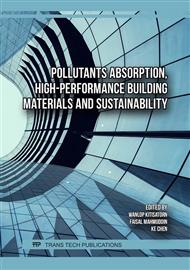[1]
F. Ma et al., "Biochar for asphalt modification: A case of high-temperature properties improvement," Science of the Total Environment, vol. 804, Jan. 2022.
DOI: 10.1016/j.scitotenv.2021.150194
Google Scholar
[2]
C. Martínez-Toledo, G. Valdés-Vidal, A. Calabi-Floody, M. E. González, and O. Reyes-Ortiz, "Effect of Biochar from Oat Hulls on the Physical Properties of Asphalt Binder," Materials, vol. 15, no. 19, Oct. 2022.
DOI: 10.3390/ma15197000
Google Scholar
[3]
S. Zhao, B. Huang, X. P. Ye, X. Shu, and X. Jia, "Utilizing bio-char as a bio-modifier for asphalt cement: A sustainable application of bio-fuel by-product," Fuel, vol. 133, p.52–62, Oct. 2014.
DOI: 10.1016/j.fuel.2014.05.002
Google Scholar
[4]
S. Zhao, B. Huang, X. Shu, and P. Ye, "Laboratory investigation of biochar-modified asphalt mixture," 2014, National Research Council.
DOI: 10.3141/2445-07
Google Scholar
[5]
N. Howell, A. Pimentel, and S. Bhattacharia, "Material properties and environmental potential of developing world-derived biochar made from common crop residues," Environmental Challenges, vol. 4, Aug. 2021.
DOI: 10.1016/j.envc.2021.100137
Google Scholar
[6]
K. K. Supervisors, T. Lombardi, A. B. Co-Supervisor, and M. Rovai, "Bitumen fumes, impacts on human health and natural environment. Reduction, prevention and control of bitumen fumes in road construction industry. Thesis work," 2011.
Google Scholar
[7]
K. Sonibare, G. Rucker, and L. Zhang, "Molecular Dynamics Simulation on Vegetable Oil Modified Model Asphalt," 2020.
Google Scholar
[8]
X. Zhou, T. B. Moghaddam, M. Chen, S. Wu, and S. Adhikari, "Biochar removes volatile organic compounds generated from asphalt," Science of the Total Environment, vol. 745, Nov. 2020.
DOI: 10.1016/j.scitotenv.2020.141096
Google Scholar
[9]
S. Chebil, A. Chaala, and C. Roy, "Use of softwood bark charcoal as a modifier for road bitumen." [Online]. Available: www.elsevier.com/locate/fuel
DOI: 10.1016/s0016-2361(99)00196-9
Google Scholar
[10]
X. Zhou et al., "Effects of biochar on the chemical changes and phase separation of bio-asphalt under different aging conditions," J Clean Prod, vol. 263, Aug. 2020.
DOI: 10.1016/j.jclepro.2020.121532
Google Scholar
[11]
Y. Wu et al., "Modeling of the Complex Modulus of Asphalt Mastic with Biochar Filler Based on the Homogenization and Random Aggregate Distribution Methods," Advances in Materials Science and Engineering, vol. 2020, 2020.
DOI: 10.1155/2020/2317420
Google Scholar
[12]
J. Deng et al., "Competitive adsorption of Pb(II), Cd(II) and Cu(II) onto chitosan-pyromellitic dianhydride modified biochar," J Colloid Interface Sci, vol. 506, p.355–364, Nov. 2017.
DOI: 10.1016/j.jcis.2017.07.069
Google Scholar
[13]
H. Maljaee, R. Madadi, H. Paiva, L. Tarelho, and V. M. Ferreira, "Incorporation of biochar in cementitious materials: A roadmap of biochar selection," May 10, 2021, Elsevier Ltd.
DOI: 10.1016/j.conbuildmat.2021.122757
Google Scholar
[14]
L. Restuccia et al., "Mechanical characterization of different biochar-based cement composites," in Procedia Structural Integrity, Elsevier B.V., 2020, p.226–233.
DOI: 10.1016/j.prostr.2020.04.027
Google Scholar
[15]
A. Mardani, A. Jusoh, K. M. D. Nor, Z. Khalifah, N. Zakwan, and A. Valipour, "Multiple criteria decision-making techniques and their applications - A review of the literature from 2000 to 2014," Economic Research-Ekonomska Istrazivanja , vol. 28, no. 1, p.516–571, Sep. 2015.
DOI: 10.1080/1331677X.2015.1075139
Google Scholar
[16]
A. Sain, A. Gaur, · Prakash Somani, · Jeetendra, S. Khichad, and · Ghanshyam Balotiya, "Characterization and Evaluation of Bamboo Species for Construction Applications Incorporating TOPSIS, AHP and VIKOR," Arabian Journal for Science and Engineering 2024, p.1–17, Mar. 2024.
DOI: 10.1007/S13369-024-08797-X
Google Scholar
[17]
E. Triantaphyllou, "Multi-criteria Decision Making Methods: A Comparative Study," vol. 44, 2000.
DOI: 10.1007/978-1-4757-3157-6
Google Scholar
[18]
A. Sain, A. Gaur, P. Somani, J. S. Khichad, and G. Balotiya, "Characterization and Evaluation of Bamboo Species for Construction Applications Incorporating TOPSIS, AHP and VIKOR," Arab J Sci Eng, p.1–17, Mar. 2024.
DOI: 10.1007/s13369-024-08797-x
Google Scholar
[19]
G. Balotiya, A. Gaur, P. Somani, and A. Sain, "Investigating mechanical and durability aspects of concrete incorporating Wollastonite and bottom ash," Mater Today Proc, Jun. 2023
DOI: 10.1016/J.MATPR.2023.06.048
Google Scholar



